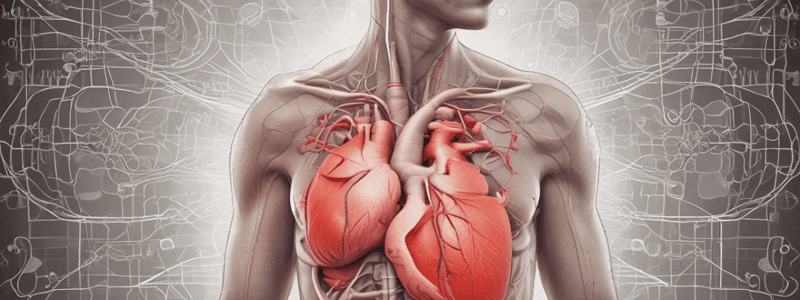Podcast
Questions and Answers
What is the location where S1 is loudest?
What is the location where S1 is loudest?
- Second left intercostal space
- Right fourth intercostal space
- Left fourth intercostal space (correct)
- Second right intercostal space
What is the correct sequence of events during a cardiac cycle?
What is the correct sequence of events during a cardiac cycle?
- S2, ventricular contraction, S1, ventricular relaxation
- S1, ventricular relaxation, S2, ventricular contraction
- S1, ventricular contraction, S2, ventricular relaxation (correct)
- S1, ventricular relaxation, S2, ventricular contraction
Why is S1 not split?
Why is S1 not split?
- Because aortic and pulmonic valve closure occur during ventricular contraction
- Because mitral and tricuspid valve closure occur during ventricular relaxation
- Because aortic and pulmonic valve closure occur too close together
- Because mitral and tricuspid valve closure occur too close together (correct)
What is the normal physiologic phenomenon in younger patients?
What is the normal physiologic phenomenon in younger patients?
What happens to pulmonic valve closure during inspiration?
What happens to pulmonic valve closure during inspiration?
What is the location where extra heart sounds (S3 and S4) are typically heard?
What is the location where extra heart sounds (S3 and S4) are typically heard?
Flashcards are hidden until you start studying
Study Notes
Auscultation
- Auscultation is performed using the stethoscope diaphragm.
S1 - First Heart Sound
- S1 is the loudest over the left fourth intercostal space (mitral/tricuspid valve areas).
- S1 is produced when the mitral and tricuspid atrioventricular (A/V) valves close during ventricular contraction (systole).
S2 - Second Heart Sound
- S2 is heard along the second right and left intercostal spaces (aortic/pulmonic valve regions).
- S2 is produced when the pulmonic and aortic semilunar valves close during ventricular relaxation (diastole).
Identifying S1 and S2
- The time between S1 and S2 is shorter than the time between S2 and the next S1, helping to identify which sound is produced by mitral/tricuspid valve closure and which is produced by aortic/pulmonic valve closure.
Physiologic Splitting of S2
- A slight physiologic splitting of S2 is normal in younger patients.
- Split S2 has two parts: aortic (A2) and pulmonic (P2) valve closure.
- On inspiration, S2 splits into A2 and P2 due to delayed pulmonic valve closure.
- On expiration, S2 is a single sound.
S1 and S2 Patterns
- S1 doesn't split because mitral and tricuspid valve closure occur too closely together to be heard individually.
Extra Heart Sounds (S3 and S4)
- S3 and S4 produce a gallop rhythm.
- These sounds can be heard around the fourth intercostal space on the mid-clavicular line.
- They are considered normal up to ages 20-30.
Studying That Suits You
Use AI to generate personalized quizzes and flashcards to suit your learning preferences.




